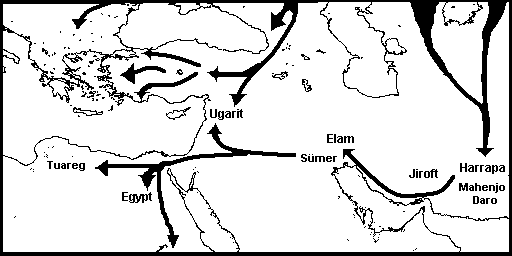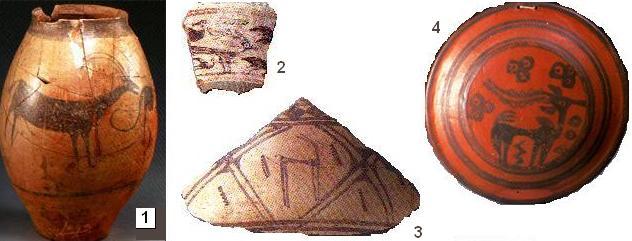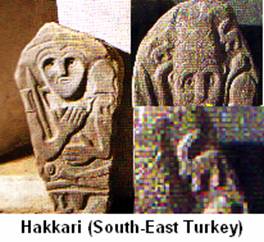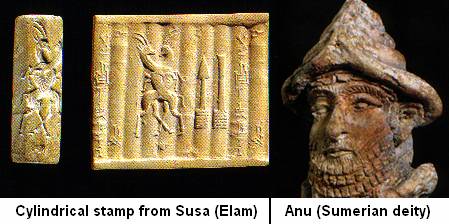|
The
south-west expansion of the Uighur people did not stop at
Harrapa and Mahenjo-Daro. From this region they went further
west to Mesopotamia and Egypt. Another wave came from the
north through the Caucasus to Eastern Anatolia and continued
further south to meet the southern people on the east coast of
the Mediterranean Sea. In this region where two groups met a
new vision developed. This new vision, based mainly on trade,
required a new system of writing. The reason being, that the
Babylonian and Assyrian cuneiforms were too cumbersome to be
used by the average trader. This is how the
Ugaritic
alphabet developed (see Chapter 13, Evolution of
writing systems). The eastern Anatolian branch dispersed
further west to build new cities along the Aegean coast and
also on the nearby Aegean and Mediterranean islands.

The
symbolism of the sacred ibex can be followed in almost all of
these regions, as a cultural indicator to the Central Asiatic
origins. On several pots and broken pottery pieces from the
Indus Valley and surrounding regions typical motifs of ibexes,
gazelles and antelopes are found (1).

1. A barrel-shaped pot decorated with a row of ibexes painted in
brown.
2.
Pottery
fragment from the early period (circa 3,000 BC) with a gazelle
among birds.
3.
A stylish ibex is found on a pottery fragment dated to the
early second millennium BC.
4.
An antelope is seen on a polished plate from burial site that
developed in and around Punjab following the peak of the Indus
Civilization.
The sacred
ibex has also found its place on the steles of Hakkari (see
map of Chapter 12, The Anatolian expansion). These
stone carvings, dated several thousand years old, suggest a
very early connection between upper Mesopotamia and Central
Asia (2). Two of the 12 carved steles found in Hakkari are
shown below. The male figures hold drinking vessels and carry
weapons, such as spears and daggers. The ibex figures (one of
them enlarged) can clearly be seen above the left shoulder.

Below we see
a cylindrical stamp found in Susa, the main city of the
Elamite culture. There are two intertwined ibexes next to an
arrow (Ok). The script on each side is Elamite and has a
precursor known as Proto-Elamite, still not deciphered
(3). H.
C. Rawlinson, who worked on the Elamite script thought that it
belonged unquestionably to the Ural-Altaic language group.
Maurice Pope says in this regard
(3):
The Elamite language had a long history behind it. Its
existence is attested in cuneiform inscriptions of the second
millennium BC, the so-called Middle Elamite, and probably
extended back at least a further thousand years; for it is
probably the language of inscriptions found at Susa in a quite
different script, which are sometimes accompanied by a text,
presumably a translation, in Akkadian cuneiform.

On the
picture above (right) we see Anu, the main Sumerian deity. Anu
is the sky-god, father and king of the Mesopotamian gods. His
first consort was Antu; from them were the Anunnaki created-
the underworld gods. When the name Anunnaki is split as
Anu-nınki we obtain a Turkish word meaning belonging to
Anu which is an appropriate name for the children of Anu.
Anu wears, as almost all Sumerian gods, a headdress formed out
of several superimposed horns (see Chapter 15,
The sacred
horn).
|